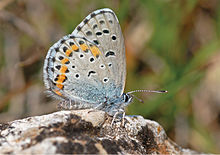You can help expand this article with text translated from the corresponding article in Russian. (April 2023) Click for important translation instructions.
|
| Pseudophilotes bavius | |
|---|---|

| |
| Scientific classification | |
| Domain: | Eukaryota |
| Kingdom: | Animalia |
| Phylum: | Arthropoda |
| Class: | Insecta |
| Order: | Lepidoptera |
| Family: | Lycaenidae |
| Genus: | Pseudophilotes |
| Species: | P. bavius |
| Binomial name | |
| Pseudophilotes bavius (Eversmann, 1832) | |
| Synonyms | |
| |
Pseudophilotes bavius, the Bavius blue, is a butterfly of the family Lycaenidae. It is found in Morocco, Algeria, Bulgaria, Romania, Greece, Asia Minor, southern Russia and northern Kazakhstan. The species occurs in small isolated populations on flower-rich, dry grassland, on dry, stony slopes and on open patches in shrub and in vineyards on calcareous soil.
The wingspan is 24–30 mm. Adults are on wing from April to May and again from June to July in two generations per year. There is usually one prolonged generation a year with adults on wing from late April to mid-July. In Peloponnesus, a partial second generation may occur.
The larvae feed on Salvia species, including S. officinalis, S. nutans, S. verbenaca and S. verticillata. They feed mostly on the flowers, but sometimes also on the leaves. They are frequently found with ants. Hibernation takes place in the pupal stage.
Subspecies
- Pseudophilotes bavius bavius (steppe of southern Russia, northern Kazakhstan)
- Pseudophilotes bavius casimiri Hemming, 1932 (Peloponnesus)
- Pseudophilotes bavius hungarica (Dioszeghy, 1913) (Transylvania)
- Pseudophilotes bavius fatma (Oberthür, 1890) (Morocco: Middle Atlas, Algeria: Aures Mountains)
- Pseudophilotes bavius egea (Herrich-Schäffer, ) (Caucasus)
- Pseudophilotes bavius macedonicus Schultze, 1958 (Macedonia)
- Pseudophilotes bavius eitschbergeri (Koçak, 1975) (Turkey)
- Pseudophilotes bavius vanicola (Koçak, 1977) (Turkey)
Etymology
Named in the Classical tradition.Bavius was a Roman poet.
References
- Pseudophilotes at Markku Savela's Lepidoptera and some other life forms
- "treknature". Archived from the original on 2016-11-14. Retrieved 2012-03-23.
- C. Van Swaay; et al. (2012). "Dos and Don'ts for butterflies of the Habitats Directive of the European Union". Nature Conservation. 1: 73–153. doi:10.3897/natureconservation.1.2786.
 This article incorporates text available under the CC BY 3.0 license.
This article incorporates text available under the CC BY 3.0 license.
| Taxon identifiers | |
|---|---|
| Pseudophilotes bavius |
|
| Lycaena bavius | |
This Polyommatini-related article is a stub. You can help Misplaced Pages by expanding it. |